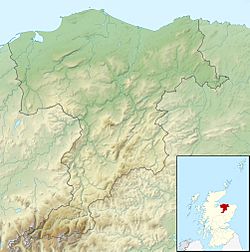Auchinhove facts for kids
Quick facts for kids Auchinhove |
|
|---|---|
| Type | Marching camp |
| Location | |
| Coordinates | 57°33′10″N 2°54′03″W / 57.5527°N 2.9007°W |
| Site notes | |
| Discovery year | 1949 |
| Condition | Cropmark |
| Archaeologists | Kenneth St Joseph |
Auchinhove is the site of an ancient Roman marching camp. It is found in Moray, Scotland, near a town called Keith. This camp was first spotted from the air in 1949.
Roman marching camps were temporary forts built by the Roman army. They used these camps when they were on the move or exploring new lands. Auchinhove gives us clues about where the Romans traveled in Scotland.
Contents
What is a Roman Marching Camp?
A Roman marching camp was like a temporary military base. Roman soldiers built these camps quickly at the end of a day's march. They were designed to protect the soldiers from enemies during the night.
The camps were usually square or rectangular. They had strong walls made of earth and wood. A ditch was often dug around the outside for extra protection. Inside, soldiers would set up their tents and store their supplies.
Why Did Romans Build Them?
The Roman army was very organized. When they marched into new areas, they needed safe places to rest. Building a camp every night was a standard part of their routine.
These camps allowed the soldiers to sleep safely. They also provided a secure place for their equipment and food. Marching camps were essential for the Roman army to travel far and wide.
Discovering Auchinhove
Auchinhove was discovered using a special method called aerial photography. This means taking pictures from an airplane. From high above, things on the ground that are hard to see normally can become clear.
In this case, the old Roman camp walls were no longer standing tall. But over time, they had affected the soil. This caused the crops growing above them to look different. These differences showed up as patterns in the aerial photos, revealing the camp's outline. These patterns are called cropmarks.
How Big Was the Camp?
The Auchinhove camp was quite large. It measured about 337 meters (1,106 feet) long. It was also about 328 meters (1,076 feet) wide.
This means the camp covered an area of about 10.9 hectares (27 acres). To give you an idea, that's roughly the size of 15 football fields! A camp this size could hold many Roman soldiers and their gear.
Roman Presence in Scotland
The discovery of camps like Auchinhove helps us understand Roman history in Scotland. The Romans tried to conquer parts of Scotland, but they never fully succeeded. These camps show us how far north they traveled.
Auchinhove is one of many Roman sites found in Scotland. Each discovery adds to our knowledge of this ancient time. It helps us imagine what life was like for the Roman soldiers exploring new lands.


